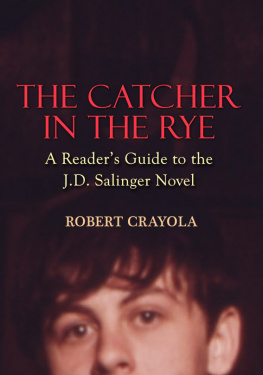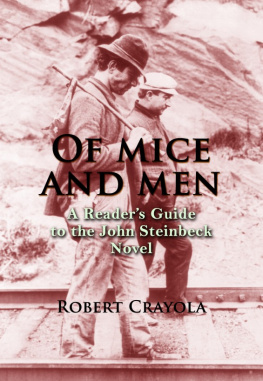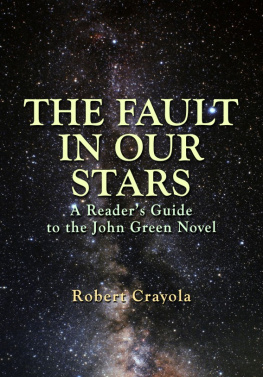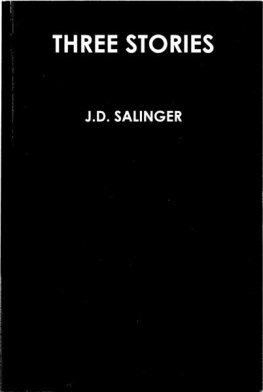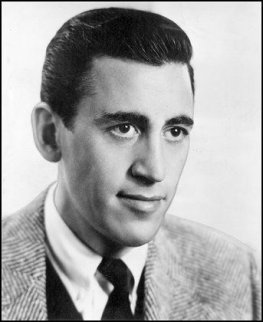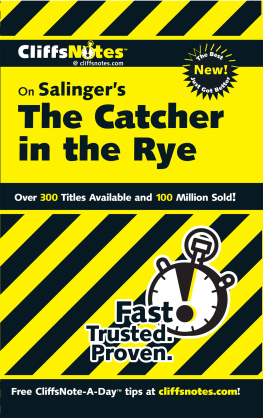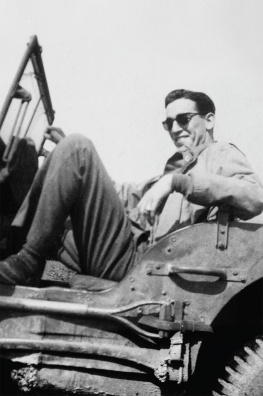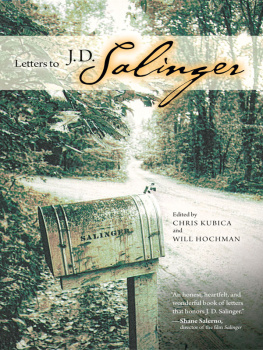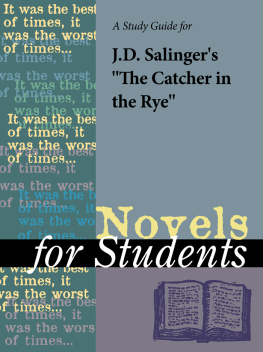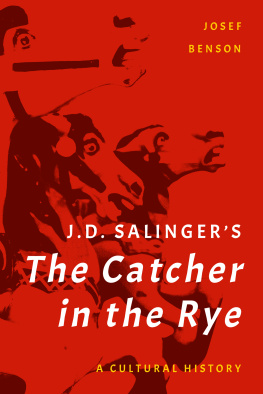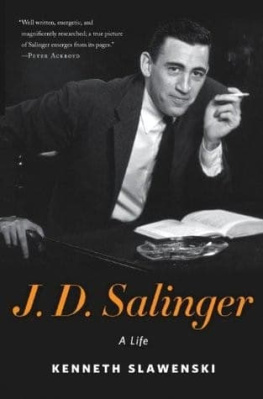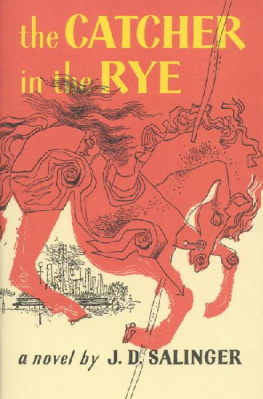The Catcher in the Rye:
A Reader's Guide to the J.D. SalingerNovel
by Robert Crayola
Smashwords Edition
Copyright 2014 Robert Crayola
https://www.smashwords.com/profile/view/robertcrayola
****
CONTENTS
Welcome to The Catcher in the Rye: AReader's Guide to the J.D. Salinger Novel. This guide will addto your understanding of the book and get you thinking about itsdeeper dimensions. We will examine it from a variety of angles andthis will be beneficial whether you are totally new to the book orhave already familiarized yourself with the text.
The Catcher in the Rye has been abestseller for over sixty years now. Something about it has toucheda chord with readers, especially young people. We'll try to findout what its appeal is in this guide.
Let's begin our study by looking at theauthor, J.D. Salinger.
AUTHOR: Jerome David Salinger wasborn in New York City on January 1, 1919. He was raised Jewish butwould later learn that his mother wasn't actually Jewish. Hepublished in school newspapers growing up and was socially activein numerous clubs.
After high school, he began college at NYUbut soon dropped out. He tried to make it in the meat-packingindustry, even going to Austria for the business, but he quicklyreturned just before the Nazis annexed Austria.
He began college once more in Pennsylvaniaand again dropped out. He continued writing, however, and took awriting class at Columbia University. He had his first storyprofessionally published in Story magazine in 1940. He wouldsubmit stories to the New Yorker and finally had "SlightRebellion off Madison" accepted, but because of the war references,it was not published until 1946. It featured the character ofHolden Caulfield, later the narrator in The Catcher in theRye.
In 1942 Salinger was drafted and servedactive duty during several major battles. While in Europe, hearranged to meet Ernest Hemingway, whom he respected. Hemingway sawgreat promise in the young writer and encouraged him.
Salinger continued to write and submitstories during the war, but he suffered a great deal of traumaticstress. When the war ended, he married a German woman and returnedwith her to the U.S. The marriage failed after eight months and shereturned to Germany.
Salinger tried to have a book of storiespublished at this time, but the deal fell through. He continued towrite and publish, and with the publication in The New Yorker of "APerfect Day for Bananafish" he secured a contract with the magazinethat gave them first-rights to publish his stories. He wouldrelease short works mainly through them for the remainder of hiscareer. The story would mark the first appearance of the Glassfamily, and Salinger would use them in numerous other stories.
About this time, he also took a stronginterest in Zen Buddhism. It would be the first of many schools ofthought to interest him. He would take his practices very seriouslyand often encourage or force others close to him to adhere to hissystems.
In an attempt to secure more money, Salingersold the film rights of a story to Hollywood and they turned itinto My Foolish Heart. He hated the film and vowed to neverhave one of his works mutilated in that way again.
In the late 40s Salinger began work on hisfirst novel, The Catcher in the Rye. It featured HoldenCaulfield from his earlier story and was a semi-autobiographicaltale of a disaffected youth. It would be published in 1951 toenormous success, earning critical acclaim, banned in somecountries and schools, and still selling about 250,000 copies ayear to this day.
A second book followed in 1955: NineStories, collecting a variety of material. It was alsosuccessful. Salinger's growing fame was unwelcome, and he movedfrom New York to New Hampshire and began to live a more reclusivelifestyle, also publishing less. He married in 1955 and had twochildren before divorcing in 1967. He would publish his two finalbooks in the early 1960s: Franny and Zooey, and RaiseHigh the Roof Beam, Carpenters and Seymour: An Introduction.His final published work was a novella in 1965.
Salinger's home life is reported as beingregimented and peculiar. It's hard to say how accurate thesedescriptions are. They mainly come from writer Joyce Maynard, whohad a 9-month relationship with Salinger in 1972 when she was 18and he was 53, and his daughter Margaret Salinger. Scrutiny in thereclusive author didn't abate. His son would denounce the viewpointtold by Salinger's daughter in her memoir, leaving many questionsunanswered. Salinger died on January 27, 2010 at age 91, andscrutiny and interest by fans continue to this day with the releaseof the documentary Salinger.
CONTEXT: We should keep the book'sera in mind when we read it. It seems to take place in the late1940s when America was beginning to experience a new prosperity.People had returned from World War II and wanted a safe familylife, the American dream of a home, and steady work. Much of thiswill be lambasted in Holden Caulfield's narration. He can't standthe mindless conformity and stupidity he sees all around him. In asense, his feelings will erupt in the 1960s, but he is a little tooearly, and he would probably find the 60s as easy to criticize asany era.
WHAT KIND OF BOOK IS THIS?:TheCatcher in the Rye is an average-length novel.
STRUCTURE: The book is divided into26 chapters. 25 chapters are devoted to Holden's narration ofevents over a few days before Christmas. The last short chapter hasHolden reflect on his story.
SETTING: Setting is the time andplace that a story occurs. The time is the late 1940s. The bookbegins with Holden at a private high school in the fictional townof Agerstown, Pennsylvania. He will leave there after a fewchapters and the remainder will take place in New York City.
NARRATOR AND P.O.V.: The narrator isHolden Caulfield, one of the most famous characters in fiction. Hisis 16 years old for the events in the novel. He is very disgruntledabout almost everything and doesn't know what to do with himself.We might question the accuracy of much of his story. When anarrator cannot always be trusted to be 100% accurate, we call himor her an unreliable narrator. Although we can trust thegeneral accuracy of events, Holden might not always relate thedetails completely right, softening things to make him look betterand others look worse.
TENSE: The book is "written" byHolden a few months after the story's events and is written in thepast tense.
TONE: Tone is how a bookfeels. Because Holden is bitter about many things in thebook, the tone is very pessimistic. Rarely a page passes withoutHolden describing something as depressing.
PLOT: The story of The Catcher inthe Rye concerns Holden Caulfield and how he spends a couple ofdays before Christmas. He is a teenager attending a private schoolin Pennsylvania, and he is kicked out. It is the latest in a seriesof schools to kick him out for underperformance. Rather than remaina few more days at the school, he decides to leave for New York(where his family lives) early and stay in a cheap hotel.
Over the next few days he has a series ofencounters with various people in all walks of life. His overallattitude is one of pessimism and depression, and the adventures hehas only serve to make him feel worse. He almost loses hisvirginity to a prostitute, gets beat up by her pimp, goes tovarious bars trying to get drunk, and meets a few old friends.
When his money runs out he sneaks into hisparents' home and borrows more cash from his younger sister Phoebe.He decides he will hitchhike out west and start a new life forhimself. However, when he meets his sister again to return hermoney, she convinces him not to run away. The book concludes withHolden recovering from a nervous breakdown in California,reflecting on the experience of those few days.
Next page
